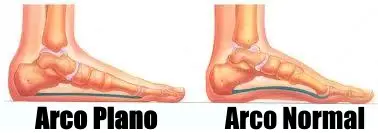In previous columns, I have reviewed some of the deformations that affect the spine such as height or knee problems.
This time, I want to call start talking about feet. In particular of flat feet. An interesting study that demonstrates cóhow lack of arch can have a physiological impactómeaningful magic.
It makes sense that quiropráskeptic see how biomecháabnormal sole of the foot to result in a functioning fíphysical más difficult
Intellectually, we can formulate the hipóthesis that not having a bow willíto a less effective push, since the foot does not become the necessary “lever ríhome” to the detachment of the fingers. This, Thus, hairíto which the use of energyía sea más inefficient when walking.
The end result appears to be más the energy consumptionía and greater fatigue than necessary when walking. Intuitive level, this concept sounds good – but ¿are cientíphysically accurate?

A study of 1988 investigativeó is the theme, and approachedó with some very interesting conclusions. The results of this study are very important to chiropráskeptic, if they try a prágeneral practice or work with athletes based in performanceñO.
Judge for yourself if some of your patients have not been considered for orthoticsétips, mayístill benefit greatly.
Index
energy useíto and flat feet
The three researchers who wantedístill investigate the hipóprevious thesis haveía background in medicine nísica, therapy física y rehabilitationón. His goal was to perform a “comparative study… to evaluate the effects of the arch of support on the consumption of oxígeno.”
The experimental subjects were 40 women between the ages of 18 and 38 años. All the women were in good health, no complaints in feet or lower extremities.
From X-ray measurements, they were selected 20 women who meetístill the diagnostic criteriaóflat pie sticks. The others 20 healthy women were used as a control group.
Test subjects
All subjects had several pairáphysiol metersóproven magicians – Resting, así like walking on a treadmill in three levels of speed and inclineón, and lateréis the recoveryón.
Measurements included ECG, presión arterial sistólica y diastófaces, pulse rate, and the consumption of oxígeno.
The cost of energyíto walk was calculatedó multiplying the milliliters of oxígeno consumed per minute times the subject's weight in kilograms. This initial test providedó baseline for all women in the study.
At 20 women with flat feet were provided with custom arch supports, that they carried full time for two weeks.
At that point, the same physiologic testing proceduresógical tests were performed again on all subjects, with the experimental group who wore their personalized supports.
Results
The control group did not showó differences in any of the measurements from the first trial to the second trial. There were no changes in the rest measurements of the group wearing arch supports.
This demonstrates the consistency and validity of the measurements made by the researchers..
Significant differences were observed in the walking and recovery measurements.óNo of experimental group (those who carry the supports for the arch).
Your card frequenciesíwere they significantly moreás slow, come onón arterial sistólica was más baja, ox consumptionígene was less, and its cost of energyía calculated was much less.
These differences were más evident at walking speeds más ráI ask and the inclinationón más high, how can iíto be anticipated.
Adequate arch support
It was usedó a control group, since it was possible that two weeks más later they could demonstrate a better performanceñor because the subjects haveían más experience with test procedures. In this studio, the control group did not showó andúno significant change between the two tests.
Significant improvements in physiological performanceóin the experimental group can confidently be attributed to the use of arch supports.
The authors of the studyñpraised that “ox consumptionígeno can be reduced in patients with flat feet, simply through the applicationón adequate arch support.”
¿Whaté it's a “adequate support arch?” These researchers took weight-bearing footprints from each experimental subject., made several measurements, and built a polyethylene medial arch support.
This support for the custom-made arch is then inserted into the leather of the shoe to prevent displacement.. Así, in this studio, These orthoses were built on the basis of a “weight lifting, positionóno functional” foot image.
